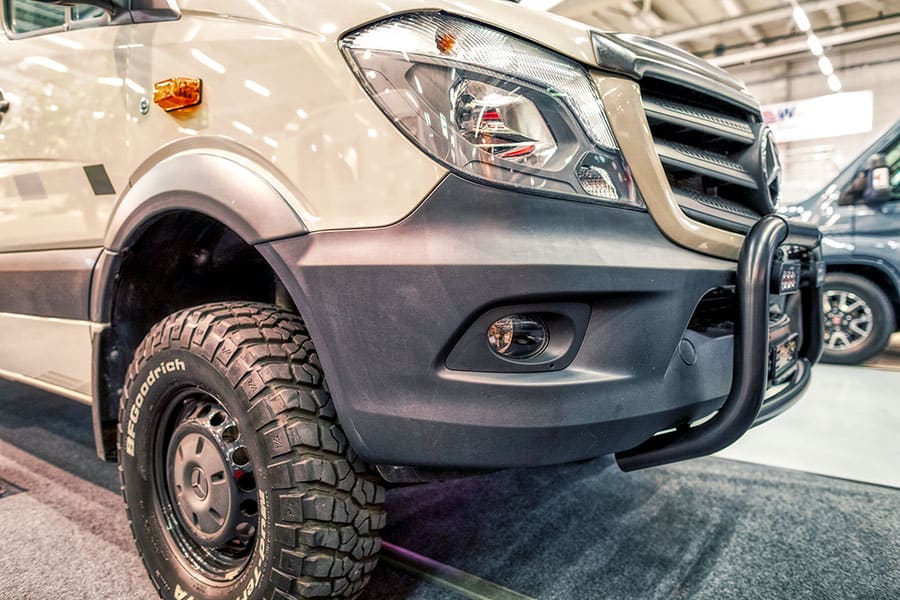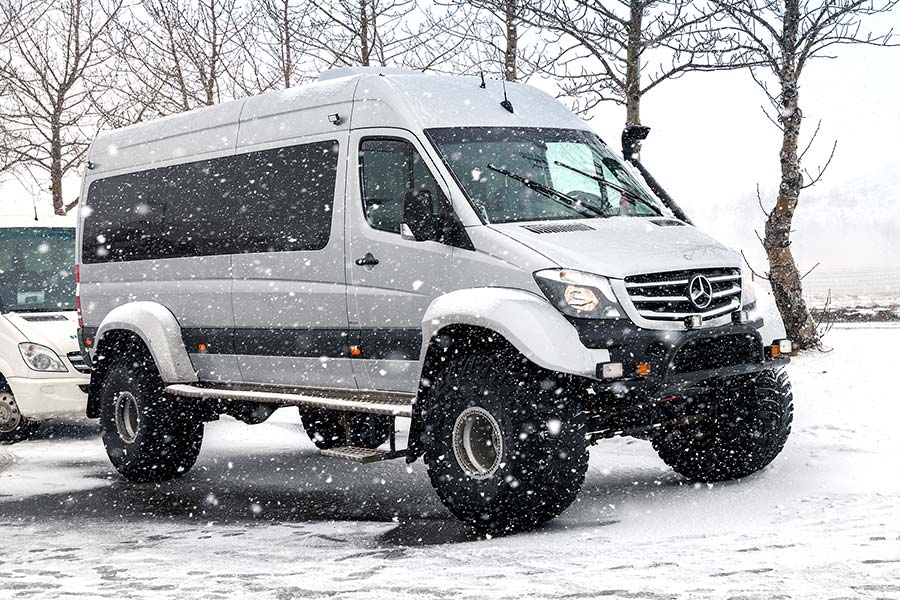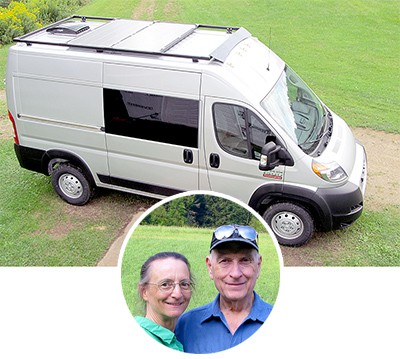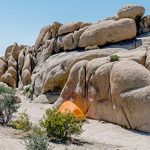
Whether you’re camping, working, or driving on various types of terrain, 4-wheel drive is a useful part of many modern vehicles. The problem is that it’s often only available on trucks and cars commonly used for adverse road conditions and off-road. Thousands of vans and compact vehicles don’t have this practical feature.
So, do any vans have 4-wheel drive? Yes! If you’re searching for one, you’re in luck. Mercedes-Benz is currently the only manufacturer that produces a 4WD van, the Sprinter, but you can also enjoy the recently released AWD Ford Transit. Fortunately, both of them don’t cost too much more than their respective stock models.
Throughout this post, you’ll learn about the following information:
- Which vans and minivans offer 4WD, and which don’t
- How you can convert your van to a 4WD vehicle
- The influence of off-road capabilities from other parts of a van
- Alternative solutions for offroading.
Which Vans Have 4-Wheel Drive?
As you probably read above, Mercedes-Benz is the only company that makes vans that come with 4-wheel drive. However, the new Ford Transit has an all-wheel-drive option if you want to improve the multi-terrain functionality of the van. Both vans are already at the top of the camper van selection for most people, making them perfect choices for 4WD enthusiasts.
If you’re not sure what the difference between 4WD and AWD is, it’s rather simple. 4-wheel drive refers to vehicles that drive with two wheels, but they have the option to switch over to 4WD when you need it the most. This option is useful when you encounter snow, mud, gravel, sand, or steep inclines.
On the other hand, all-wheel-drive refers to vans, trucks, and cars that always use all four wheels to propel themselves. Rather than having a switch to choose between two or four tires, all of them are continually running. This feature can be good and bad since using all four tires expands your off-road capabilities, but the gas consumption is usually higher.
Unfortunately, there aren’t any minivans that come with 4WD or AWD, so you’ll have to keep an eye out for challenging driving spots. However, you’ll be happy to know that there are a few alternative solutions that you can refer to at the bottom of this post if you’re concerned about it.
Contrary to what most people seem to believe, you can still drive on many kinds of terrain without using 4WD. It’s all about driving slow, gripping the steering wheel with both hands, and paying attention to your surroundings. We’ll get more into your options later on.
When it comes to conversion choices, you can switch your current van over to a 4WD in some cases. You will need to pay attention to the make, model, and specs of your vehicle compared to the manufacturer of the kit. Converting a van to 4WD isn’t cheap, but it’s more than worth the investment if you’re going to be driving in snow, mud, sand, or gravel.
Check out these five items to help you have a better camping experience:
- Biodegradable Liquid Soap
- Microfiber Towels
- 300W Power Inverter
- Battery Operated Fan
- Square Pie Iron
What Else Affects Offroad Driving?
Another common issue that people often think is that, once they get 4WD on their vehicle, they don’t have to be concerned about anything else when they’re offroading. Sadly, this misconception could lead to severe mechanical problems very quickly. Remember that almost every vehicle on the market isn’t made for intense offroad ramps, inclines, and sport usage.
There are four parts of a vehicle (as well as many others) that impact offroad driving:

The suspension system is very important, especially if you’re hitting speed bumps or lifting tires off of the ground.
A vehicle’s tires are just about as crucial as 4WD capabilities. You need the right type of tires to go offroad. Usually, they consist of big tires that are wider, taller, and filled with deeper tread for a better grip.
Ground clearance is also worth noting. When your vehicle is higher, the less likely you will scrape against a rock or something else on the ground. Even if you have fantastic 4WD and the best tires in the world, low clearance will ruin everything.
Keep an eye on your gears. Lower gear settings give you better control over the vehicle when you’re climbing uphill or descending downhill. With better control and more traction, you’re bound to stay on top of everything.
It’s far too often that drivers skip right over all of the minor details. These factors come back to play a huge role when you’re stuck in the mud. Merely being able to use all four tires won’t suddenly make your van capable of incredible feats. Fortunately, you can follow the suggestions above to improve your odds.
Another thing that you should keep in mind is that vans aren’t designed to roll through offroad terrain and jumps. They’re made for cargo space, whether that means more people, storage, or camping supplies. Even if you get all of the additions above, you won’t have the same range of motion as a truck.
However, having 4WD on your van is an excellent way to give yourself a broader range of camping opportunities. Being able to drive offroad prevents you from worrying about being stuck in the mud during a sudden rainstorm. You’ll also be able to park right on the beach without getting stuck in the sand!
Other Posts of Interest:
- Why We Bought A Yeti Cooler
- What Is An Inverter? Why Would I Want One In My DIY Van Build?
- Can You Sleep Sideways In A Sprinter Van?
- Can You Live in a Sprinter Van?
Alternative Solutions to 4-Wheel Drive
If you already have a van and you don’t want to buy an expensive conversion kit, there are still a few options that you can make to allow you to go offroad a bit. For example, you could follow the suggestions in the previous section. Tires are often inexpensive, coming in under $1000 for a full set for most vans.
The difference in control from tires alone is worth trying out. However, that doesn’t mean that you’ll be free to drive through the snowy mountain passes in the winter or slippery ice-covered backroads.
You also have the option of purchasing studded snow tires for improved traction on slippery roads, but many places have laws and regulations on when you can use them.
Following are a few suggestions you can try if you don’t have 4WD:
- Snow chains are one of the most common choices. Most people who live in places with brutal weather patterns keep a set of snow chains in their trunk, even if they have four-wheel drive. They’re invaluable, and you won’t have to spend too much.
- Tire socks are also a great option. Much like snow chains, they wrap around your tires to provide more traction. However, the snug fit lowers the sound of tire socks, unlike the clunky noise of snow chains.
- Tire claws are worth checking out. They’re not as common and not as useful long-term, but many people have had fantastic luck using them. On top of that, they’re much quicker and easier to put on, which makes them perfect for emergency roadside changes.
Conclusion
4WD is undeniably useful when you’re going offroad. Campgrounds are often hard to reach, especially those that sit several miles away from highways and city roads. You’ll be left driving over gravel or dirt for countless minutes, but you’ll cruise right over the path with AWD or 4WD.
Here are a few takeaways from the post:
- It doesn’t matter if you have 4WD or AWD, control of the vehicle, and awareness is far more influential.
- Gears, suspension systems, tires, and ground clearance also affect a van’s offroad capabilities.
- Snow chains, tire socks, and tire claws are excellent alternatives to 4WD if you’re driving in snow or mud.
- The Mercedes-Benz 4WD Sprinter and Ford Transit AWD vans are the only two vans that come stock with four-wheel capabilities.






